Talbot Hughes (1869-1942) stands as a significant, if sometimes overlooked, figure in the landscape of late Victorian and Edwardian British art. A painter of considerable skill and sensitivity, he dedicated his career to capturing the nuances of human emotion, the allure of idealized femininity, and the rich tapestry of historical settings. His work, characterized by meticulous detail and a romantic sensibility, offers a window into the tastes and preoccupations of his era. Beyond his painted canvases, Hughes was also a dedicated connoisseur and collector, particularly of historical costume, a passion that deeply informed his artistic practice and left a lasting legacy for future generations of researchers and designers.
Early Life and Artistic Lineage
Born in London in 1869, Talbot Hughes was immersed in an artistic environment from his earliest years. He was the son of William Hughes, a respected still-life painter, whose dedication to capturing the beauty of the inanimate world likely provided an early formative influence on young Talbot's appreciation for detail and composition. The artistic vein ran strong in the family, as his brother, Herbert Hughes-Stanton, would also go on to achieve recognition as a landscape painter. This familial connection to the arts undoubtedly nurtured Talbot's own burgeoning talents and provided a supportive backdrop for his decision to pursue a career as a painter.
His formal artistic journey and public career began to take shape in the early 1870s. Records indicate that Hughes started exhibiting his works as early as 1871, a remarkably young age which suggests a precocious talent and a serious commitment to his craft. These early exhibitions would have been crucial in establishing his presence in the competitive London art scene, allowing him to showcase his evolving style and thematic interests to critics, patrons, and fellow artists. While specific details of his formal training are not extensively documented in the provided information, his technical proficiency evident in later works suggests a rigorous grounding in academic drawing and painting techniques, common for aspiring artists of that period.
Artistic Style and Thematic Concerns
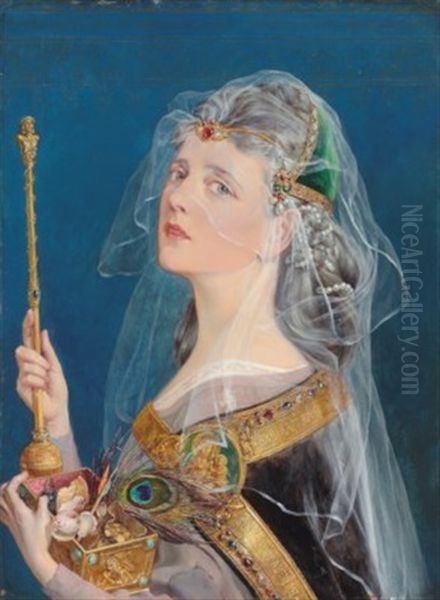
Talbot Hughes's artistic output primarily encompassed genre scenes, historical subjects, portraits, still lifes, and landscapes. However, he is perhaps best remembered for his evocative depictions of romantic encounters, moments of quiet contemplation, and scenes drawn from literature or historical anecdotes, often featuring elegant female figures. His style is marked by a high degree of finish, a delicate touch, and an almost obsessive attention to detail, particularly in the rendering of fabrics, accessories, and architectural elements. This meticulousness lent an air of authenticity and richness to his historical reconstructions.
A recurring theme in Hughes's work is the exploration of idealized female beauty and the emotional complexities of romantic love. His women are often portrayed with a gentle, sometimes melancholic, grace, embodying Victorian and Edwardian ideals of femininity. These figures are not mere decorative elements; they are often the emotional core of his narratives, conveying sentiments of longing, affection, or quiet sorrow. This focus on romantic and sentimental themes resonated with popular tastes of the time, which favored art that told a story or evoked a strong emotional response.
It is noted that Hughes was influenced by the French academic painter Jean-Louis Meissonier (1815-1891), an artist renowned for his incredibly detailed and small-scale historical and military scenes. Meissonier's painstaking precision and commitment to historical accuracy clearly found an echo in Hughes's own artistic temperament. Like Meissonier, Hughes understood the power of detail to immerse the viewer in a depicted scene, making the past feel tangible and immediate.
While distinct in their ultimate aims and symbolism, one might also draw a parallel between Hughes's attention to detail and that of the Pre-Raphaelite Brotherhood, whose leading figures like Dante Gabriel Rossetti (1828-1882), John Everett Millais (1829-1896), and William Holman Hunt (1827-1910) also emphasized truth to nature and intricate rendering in their early works. However, Hughes's art generally steered clear of the intense moral or religious symbolism often found in Pre-Raphaelite painting, favoring instead a more straightforwardly romantic or anecdotal approach.
Key Works and Their Characteristics
Talbot Hughes produced a significant body of work, with over seven hundred oil paintings and seven hundred and fifty illustrations attributed to him. Several paintings stand out as representative of his style and thematic preoccupations.
Echoes, The Garden Party, Esher , and A Court Beauty (or Court Beauties) are among his known titles. These suggest scenes of genteel society, perhaps tinged with nostalgia or romantic intrigue. The Garden Party, Esher, for instance, likely depicted an elegant outdoor gathering, offering Hughes ample opportunity to showcase his skill in rendering fashionable attire and the interplay of figures in a social setting, a popular genre also explored by contemporaries like James Tissot (1836-1902).
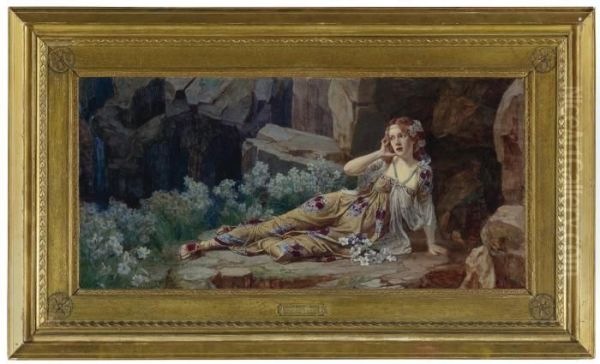
The Lady in Red (circa 1900) is specifically highlighted for its exquisite detail and interactive elements, presenting an idealized female figure. The choice of a vibrant red costume would have provided a striking visual focus, and the "interactive elements" suggest a composition designed to draw the viewer into the scene, perhaps through the figure's gaze or gesture. Such portraits of women in striking attire were a popular feature of the era, seen in the works of artists like John Singer Sargent (1856-1925), though Hughes's approach was generally more intimate and less grandly formal.
Disgrace (1892) hints at a narrative of social or romantic misfortune. The title itself evokes a story, and one can imagine a scene rich in emotional tension, likely centered on a female protagonist, with historical costumes such as crinolines and elaborate headwear playing a key role in setting the period and mood. The use of such period details was crucial for historical genre painters like Augustus Egg (1816-1863) in works like Past and Present.
Other significant works include Care (1909), Pandora, and The Toast. Pandora suggests a mythological theme, a popular subject in Victorian art, often explored by artists like John William Waterhouse (1849-1917) or Lord Frederic Leighton (1830-1896), allowing for the depiction of classical beauty and dramatic narrative. The Toast likely portrays a convivial or celebratory moment, again offering scope for character study and detailed settings. The painting Care is associated with an interesting anecdote: it was reportedly sold anonymously at one point before being rediscovered and correctly attributed, a testament to the sometimes-tenuous journey of artworks through history.
Titles such as The Story of the Hare's Escape, The Secret Transfer, and The Course of True Love Never Did Run Smooth further underscore his penchant for narrative and romantic themes. The latter, a direct quotation from Shakespeare, explicitly points to his engagement with literary sources for inspiration, a common practice among Victorian painters. These narrative works would have appealed to a public that enjoyed art that told a clear and engaging story, a tradition well-established by painters like William Powell Frith (1819-1909) with his panoramic scenes of modern life.
His repertoire also included works like Fruitful Boughs and The End of the Game, suggesting a breadth that could encompass still life elements or allegorical compositions. The sheer volume of his output across these themes demonstrates a consistent and dedicated artistic practice throughout his career.
A Passion for Authenticity: The Costume Collection
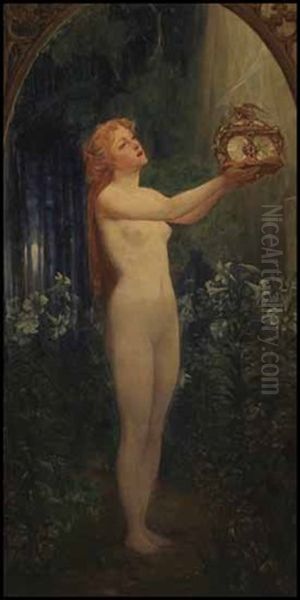
One of the most remarkable aspects of Talbot Hughes's career was his deep and abiding passion for historical costume. This was not merely a casual interest but a serious scholarly pursuit that directly informed the accuracy and richness of his paintings. He understood that authentic attire was crucial for convincingly transporting the viewer to another era. Over a period of about twenty years, Hughes meticulously assembled an extensive and significant collection of English historical clothing and accessories, spanning the 16th to the 19th centuries.
This collection was a working tool, providing him with invaluable primary source material for the figures that populated his historical genre scenes. The cut of a sleeve, the drape of a skirt, the style of a bonnet – these details, rendered with fidelity, brought a tangible sense of the past to his canvases. This dedication to historical accuracy in costume was shared by other historical painters of the era, such as Sir Lawrence Alma-Tadema (1836-1912), who was renowned for his meticulous reconstructions of the ancient world, including its material culture.
In 1913, Talbot Hughes made the decision to sell his remarkable collection to Harrods, the famous London department store. Harrods, in a grand gesture of public benefaction, subsequently presented the collection to the Victoria and Albert Museum (V&A), the national museum of art and design. This acquisition was of immense importance, as the "Talbot Hughes Collection" became a cornerstone of the V&A's fashion and textile holdings. It provided, and continues to provide, an invaluable resource for students, designers, historians, and curators.
The significance of this collection was further cemented when it was featured in the publication Old English Costumes: A Review of the Collection Formed by Mr. Talbot Hughes and Presented to the Victoria and Albert Museum, South Kensington, by Harrods Ltd. (1913). Hughes himself also authored a book on the history of Western dress, further demonstrating his expertise and commitment to the subject. This act of collecting and ensuring the preservation of these historical garments is a vital part of his legacy, extending his influence beyond his painted works into the realm of material culture and museum studies.
Professional Life and Affiliations
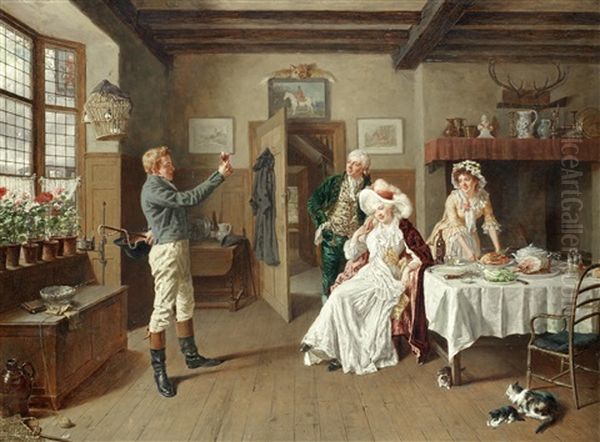
Talbot Hughes was an active participant in the London art world. His exhibiting career, which began in 1871, saw his works displayed in various galleries. His growing reputation and the respect of his peers are evidenced by his election to prestigious art societies. In 1894, he became a member of the Arts Club, a private members' club in London founded in 1863 by a group of individuals prominent in the arts, literature, or sciences, including Charles Dickens and Anthony Trollope. Membership in the Arts Club signified a certain standing within the cultural establishment.
Later, in 1903, Hughes was elected a member of the Society of Oil Painters (now the Royal Institute of Oil Painters). This society, founded in 1882, was dedicated to promoting the art of oil painting and provided a regular exhibition venue for its members. His inclusion in this society further underscores his recognition as a skilled practitioner in the medium. These affiliations provided Hughes with platforms to exhibit his work, network with fellow artists, and engage with the broader artistic discourse of his time.
The Wider Art World: Context and Contemporaries
Talbot Hughes worked during a period of significant artistic diversity and change. While he remained largely committed to a detailed, narrative, and romantic style, the art world around him was experiencing the ripples of modernism. Impressionism, Post-Impressionism, and Fauvism were making inroads, championed by artists like Claude Monet (1840-1926) and Vincent van Gogh (1853-1890), and later Henri Matisse (1869-1954). These movements challenged traditional academic approaches to art, emphasizing subjective experience, new ways of seeing, and formal innovation.
Despite these modernist currents, there remained a strong public and institutional appetite for the kind of art Hughes produced. Academic painting, historical genre scenes, and sentimental narratives continued to be popular and widely exhibited at institutions like the Royal Academy. Artists such as Lord Frederic Leighton, Sir Lawrence Alma-Tadema, and Edward Poynter (1836-1919) were leading figures in this more traditional vein, producing highly finished works often depicting classical or historical subjects.
Hughes's focus on intimate, romantic, and historical genre scenes carved out a distinct niche. His work, while sharing the meticulousness of some academic painters, often possessed a softer, more sentimental quality. He was part of a broader group of artists who catered to the Victorian and Edwardian taste for storytelling, emotional engagement, and the depiction of beauty, often with a nostalgic glance towards the past.
Later Career, Death, and Enduring Legacy
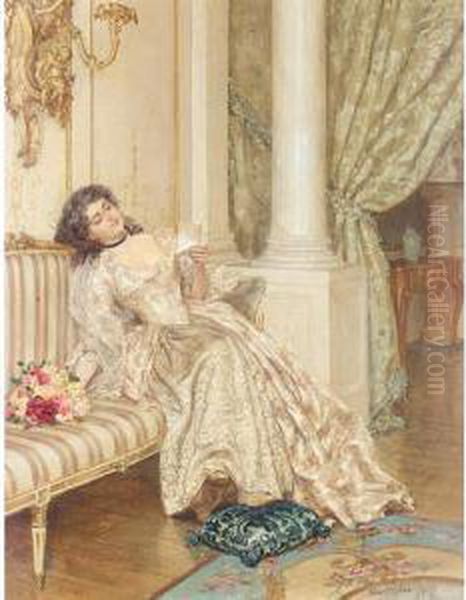
Talbot Hughes continued to paint throughout his life, leaving behind a substantial oeuvre. He passed away in 1942, having witnessed profound shifts in the art world and society at large. While his style of painting may have been seen as increasingly traditional in the face of modernism's ascendancy, his skill and the appeal of his subjects ensured him a continued, if perhaps quieter, presence.
His legacy is twofold. Firstly, there are his paintings themselves. These works remain as charming and evocative examples of late Victorian and Edwardian romantic genre painting. They offer insights into the aesthetic preferences of the era, particularly the idealization of female beauty, the fascination with historical settings, and the taste for narrative art. His paintings continue to appear at auction and are held in various collections, appreciated for their technical finesse and sentimental appeal.
Secondly, and perhaps more enduringly in a public institutional sense, is his contribution to the study of historical costume. His foresight and dedication in assembling his remarkable collection, and its eventual transfer to the Victoria and Albert Museum, have provided an invaluable resource for generations. This collection ensures that Talbot Hughes's name is remembered not only as a painter but also as a significant connoisseur whose passion has benefited the fields of fashion history, textile studies, and museum curation. His book on costume further solidifies this aspect of his contribution.
Conclusion
Talbot Hughes was an artist deeply attuned to the romantic and historical sensibilities of his time. His paintings, characterized by their delicate execution, meticulous attention to detail, and focus on themes of love, beauty, and historical narrative, provide a captivating glimpse into the artistic tastes of the late 19th and early 20th centuries. While he may not have been a radical innovator in the vein of his modernist contemporaries, his dedication to his craft, his ability to evoke emotion, and his profound understanding of historical aesthetics grant him a secure place in the annals of British art. Beyond his canvases, his extraordinary collection of historical costumes stands as a lasting monument to his passion for authenticity and his invaluable contribution to our understanding of the material past. Talbot Hughes, the painter and the collector, thus leaves a rich and multifaceted legacy.